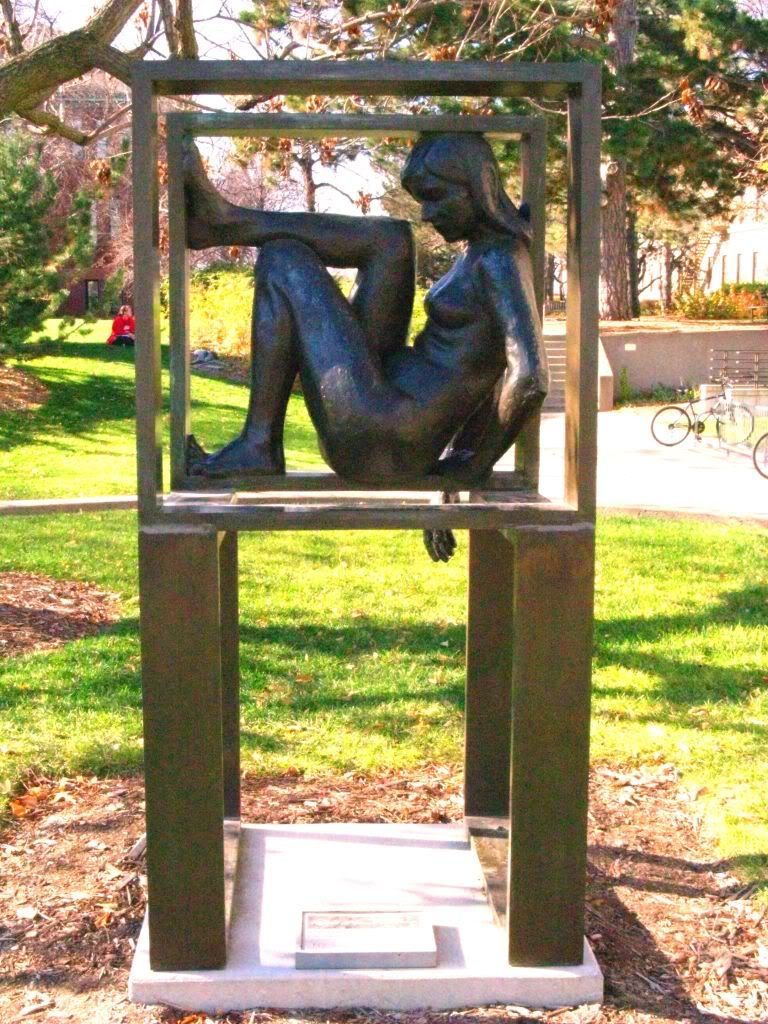 The year is 1967. NASA's Apollo 1 catches fire on the launch pad killing three astronauts. Martin Luther King Jr. publicly denounces the Vietnam War. Race riots become almost common across the United States. Segregationist Lester Maddox becomes the Governor of Georgia, and a little know sculpture, "SANDY: in Defined Space" is molded and placed in the University of Nebraska's sculpture garden.
The year is 1967. NASA's Apollo 1 catches fire on the launch pad killing three astronauts. Martin Luther King Jr. publicly denounces the Vietnam War. Race riots become almost common across the United States. Segregationist Lester Maddox becomes the Governor of Georgia, and a little know sculpture, "SANDY: in Defined Space" is molded and placed in the University of Nebraska's sculpture garden.1967 was a tumultuous time in our nation's history. Many people were simultaneously trying to carve out their own rights while avidly going against what the government was doing such as the Vietnam War. A man named Robert McDermott Miller created a sculpture that seems to be very characteristic of the time period and can be seen as somewhat of a protest piece if it is taken the way that seems to make the most sense. In the simplest form, SANDY is a woman sitting nude amongst several square geometric shapes, several feet above the ground. Her body is rough and unpolished whereas, in contrast, the shapes surrounding her are highly refined and have a bit of a shine to them.
Beyond the first obvious appearance of the sculpture, there also lies an enormous amount of symbolism and idealism that ties directly in with the theme of being a symbol of the  desegregation of gender movement of the 1960s. When you take a look at the sculpture in terms of piecing different parts with a portion of the movement, it is quite obvious what is what. By taking SANDY as a representation of all women and the geometric figures as a form of societal foundation on which gender roles are built or held, it is possible to see that SANDY is less "Defined," but more "confined."
desegregation of gender movement of the 1960s. When you take a look at the sculpture in terms of piecing different parts with a portion of the movement, it is quite obvious what is what. By taking SANDY as a representation of all women and the geometric figures as a form of societal foundation on which gender roles are built or held, it is possible to see that SANDY is less "Defined," but more "confined."
When looking at SANDY, her skin is noticeably rough and unfinished, much like the way that women at that time may have felt. Women had made great progress to get complete fairness and rights, but in the grand scheme, still lacked much of that that men were able to benefit from. Also, the geometric shapes are finished and smooth with sharp edges and defined corners. This is a representation of the framework that has been built, fortified and held over women for centuries. It is what has kept women in an exact role without giving them much of the freedom that men have.
Another clear way to see the distinction of this theme is to break down the sculpture into pieces. Notice there are pairs of nearly everything in this sculpture. The base of the woman’s position is made of two geometric, open squares places symmetrically side by side. Above them are two more shapes placed perpendicularly, but still symmetrical and the same. Yet arguably the most important key piece of the entire sculpture, SANDY, is all by herself leaving the piece somewhat off-balanced and also providing a bit of uniqueness that creates the main meaning behind the artist’s intentions. Should SANDY be missing from this sculpture, the piece would be nothing more than a framework with no over-the-top meaning.
Given of course that SANDY is present, it would be key to analyze, what is missing? The pair to a woman of course would be a man. Taken that the shapes surrounding SANDY represent the framework of a female oppressive society, the absence of a man obviously shows that men don’t abide by the same code and rules that keep women held to a certain set of guidelines.
Another piece of interest is the positioning of objects within the sculpture. SANDY is seen sitting pushed up against every edge of the square. This could be taken as a woman pushing against the confines that hold her. Also notice that her right arm is fallen limply outside the box showing that she may be working toward breaking out of the structure keeping her enclosed. On the other hand, a man may not necessarily be “missing” from the sculpture, but Miller may have just intended the idea of the sculpture to be taken very liberally. Should a man walk up to the edge of the side opposing SANDY and peer inside, he would become part of the piece. As a man, he would not be held to the same confines as SANDY and thus by looking in from the outside proves the point that the same framework that holds women does anything but for men. Taken to even more of an extreme, if a man used the structure to brace himself while looking inside, he also could be taken as aiding the framework to hold the woman and could be seen as anything but empowering.
All this said, it is easy to see that with all these examples and pieces of symbolism, there is no doubt that Miller intended this piece as a criticism of feminist oppression. The 60s was a time for self exploration and a new desire to expand horizons and create new ideas. Sculptures such as “SANDY: in Defined Space” pushed the limits between appreciated and acceptable. Using these less than conservative ideas, we can easily see that Miller intended this piece for much more than a naked woman on a college campus.
No comments:
Post a Comment